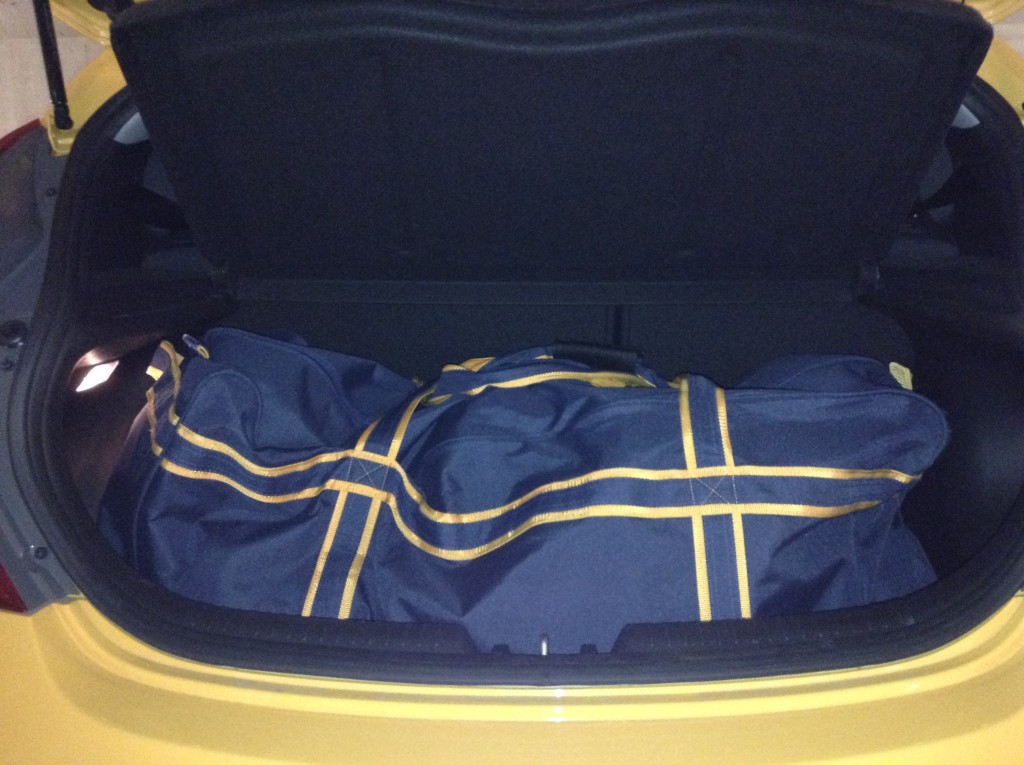Sunflower Yellow.
This colour made me chuckle when I saw it on the 2015 5-door Hyundai Accent I picked up from Hyundai’s offices north of Toronto one fine summer morning. For the record, Hyundai credibly describes the colour as “vibrant.”
Here’s my impression: I had just spent several weeks volunteering at the 2015 Pan Am Games. My uniform consisted, in part, of a shirt that another writer described as “neon cantaloupe” and other, more persnickety types insisted on calling “marigold yellow.” Suffice it to say this shirt made me highly visible. After the Games, I thought I’d leave “vibrant” colours behind me for a while, but no. Not for another week, at least.

Bringing out the Toronto 2015 Pan Am Games uniform again for comparison with the 2015 Hyundai Accent in Sunflower Yellow .
Colour aside, the Accent makes a good first impression thanks to what Hyundai calls “Fluidic Sculpture.” A collection of surfaces meet at edges that aren’t too sharp, resulting in a handsome and slippery overall look. (Hyundai claims a drag coefficient of 0.30).
Hyundai leant me the Accent in Sport Appearance Package trim. It’s based on the Accent GL and adds a sunroof, fog lights, 16″ alloy wheels and other upgrades.
Interior
The sunroof-lowered ceiling only brushed against my hair – I wasn’t obliged to bend my head one way or the other. After sighing with relief that driving the vehicle wouldn’t bring on a chiropractor visit, I toggled the manual seat adjustments on the side and front of the seat to get more comfortable. Other creature comforts include available heated front seats, cruise control, exterior temperature indicator, air conditioning and heated side mirrors.
I raised the headrest to the proper level, then realized that the headrest is so large it impeded my left shoulder check a little. Hyundai might want to make the headrest a little smaller.
Impressively, I could sit up straight in the back seat, and my legs weren’t crammed against the back of the front seat. (Quick reminder to regular readers: I’m 6’5″.) I attribute this back-seat accomplishment (hmm, that doesn’t sound quite right) to rear seats mounted low to the floor. My first clues: my knees stuck up, and; my thighs wouldn’t rest on the seats. I wouldn’t want to spend a long trip in the back seat, but the sufficient headroom impressed me. (Such headroom isn’t likely on the Accent sedan with its sloping roof and rear window. I haven’t tested it myself. Your mileage may vary.)
I got out of the back seat to confirm my initial impression of the Accent’s size. Like other automakers, Hyundai successfully practices automotive trompe l’oeil. This really does look like a small car, and in good ways, it is, but it actually isn’t all that small.
Cargo capacity
The Accent aced the hockey bag test. A surprisingly deep trunk still manages to hold a spare tire under the floor covering. Another point in the hatch’s favour: the bag didn’t prop up the privacy cover when I shut the hatch.
The cargo area widens between the taillights and the wheel wells, creating niches where it’s easy to fit grocery bags and backpacks (barely, if even, visible at either end of the hockey bag in this photo).
I couldn’t easily poke my sticks over the privacy cover and the rear seats, so I opened the rear door to put them in the car.
In-car technology
Hyundai offers common in-car gizmos in simple packaging. Wired and Bluetooth connections let me hook up an iPod and BlackBerry. Tunes streamed forth from the 172-watt 6-speaker AM/FM/XM/CD/MP3 audio system. Hands-free calling happens via steering-wheel-mounted controls.
There’s no touchscreen, so there’s no navigation system or backup camera, but I’m not sure those omissions matter. (See the conclusion for my thoughts on this.). Hyundai offers conventional buttons numbered 1 to 6 on the sound system to control the radio (AM, FM, Sirius Satellite radio) and do any required Bluetooth hookups. The steering wheel also offers audio and phone control buttons.
I’d like to view more information in the small readout between the speedometer and tachometer. Drivers can already view details like engine temperature, fuel level, outside temperature, gear indicator and odometer. Higher trim levels bring more information to this screen, but I’d like to see things here that only the stereo head unit currently shows. The head unit display is so far down and to the right that I didn’t feel comfortable looking at it while driving, yet I still wanted to know things like the current radio station or the track currently playing. Having it in front of me would have made me feel safer as I sought my entertainment on the go.
Like in most cars today, I couldn’t use the in-car system to switch between useful apps like Music (default), Podcasts, audiobook readers and other third-party audio apps on my iPod. Hyundai can relegate this complaint to the past by adopting systems like Apple’s Carplay and Google’s Android Auto, and ensuring I can configure the apps I want to access in the car.
Driving impressions
Hyundai’s 1.6-litre “Gamma” four-cylinder engine puts out 138 horses at 6,300 rpm and 123 lb-ft of torque at 4,850 rpm. This respectable power output comes courtesy of tweaks like Gasoline Direct Injection (GDI), which better controls the injection of fuel into the pistons to produce better fuel economy, increased power and reduced emissions.
Maintenance-obsessed gearheads, take note: Hyundai put a timing chain in this engine.
This power travels through a 6-speed automatic that offers a Shiftronic© semiautomatic mode. Electronic throttle control quickly read my right foot’s mind, promptly propelling the Accent to safe highway merging speeds when I needed it. The performance made me wonder how much fun I would have had (surprised looks I might have earned from other drivers?) if my tester sported the 6-speed manual gearbox… maybe another time, Hyundai?
Disc brakes on all four wheels brought the Accent to firm stops.
Fuel economy
Hyundai boasts competitive fuel economy numbers, going as low as 6.3L/100km on the highway and 7.7L/100km combined for the manual (7.6L/100km for the automatic). Frugal drivers may want to check Hyundai’s claim that its ActiveECO feature on automatic models can improve fuel economy by seven percent.
Safety
The Accent features a good-sized list of safety features. Active safety mechanisms include a passenger detection system for airbags (new to the Accent for 2015), braking assist to maximize braking force in a panic stop, and electronic stability control.
Pricing and conclusion
Much of what the Accent offers seems run-of-the-mill, but when I got MSRP listings, I found myself taking another look at the car. You can get into a 5-door model for as little as $13,599 MSRP, and the top-of-the-line Accent still runs under $20,000. (Sedan models run a few hundred dollars cheaper at each trim level.)
My conclusion: the Accent makes a great case as the value-for-money champ on the Canadian car market.
Think about it. An economical engine provides a civilized highway ride and oomph when you need it. You ride in a comfortable cabin and get gobs of cargo space. Most of the modern touches you’d expect made it into this car.
Hyundai made certain “value decisions” that I can’t debate. For instance:
- There’s no touch-screen, but who needs it when you have most of the features the screen would lead to?
- No navigation system? Drivers increasingly use their phones for this.
- No backup camera? This feature will probably arrive sooner rather than later, but visibility around the car is good and I found it easy to get a feel for the car’s dimensions (particularly the rear corners) when parallel parking or backing into parking spaces.
- Manual adjustments on the seats instead of power adjustments? Didn’t miss them.
Hyundai’s entry-level offering might not be anybody’s dream car, unless you’ve owned a few vehicles and have learned to dream of motoring at a low total cost of ownership. If that sounds like you, give the Accent a spin. And if you’re worried about driving a car in drab colours, here’s a reminder…

